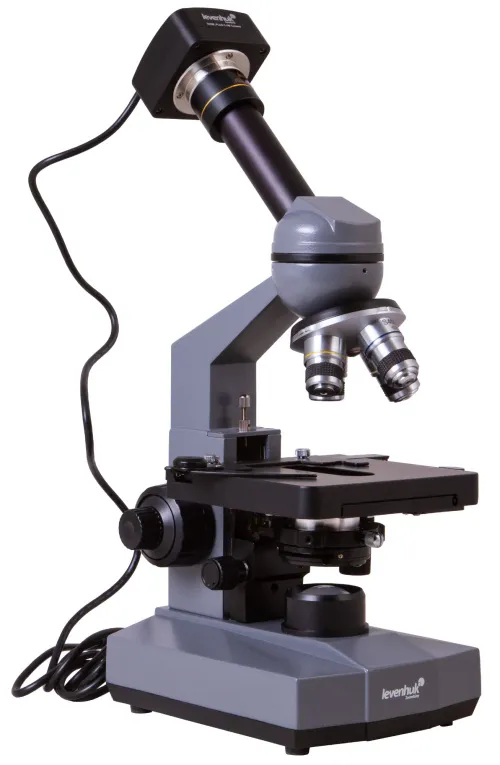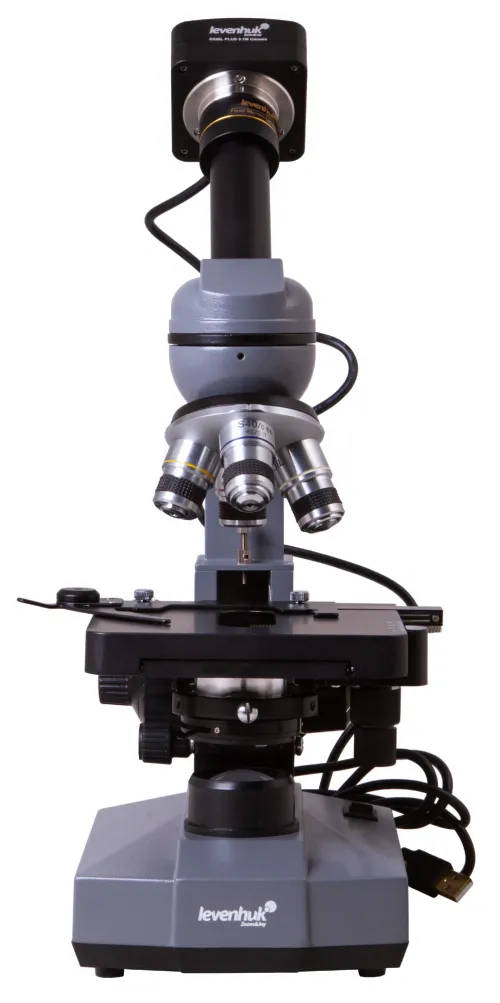Levenhuk D320L PLUS 3.1M Digital Monocular Microscope
Monocular laboratory microscope with a digital camera and LED illumination. Magnification: 40–1600x
| Product ID | 73796 |
| Brand | Levenhuk, Inc., USA |
| Warranty | lifetime |
| EAN | 5905555004501 |
| Package size (LxWxH) | 39x25x21 cm |
| Shipping Weight | 3.57 kg |
Levenhuk D320L PLUS is a microscope with a 3.1M digital camera. The microscope is designed for conducting professional laboratory research. Moreover, it is an excellent choice for holding lectures and seminars in colleges and universities. The microscope is suitable for visual observations and, what's more, it allows for recording and saving them as pictures or videos. All the necessary accessories are already included in the kit.
This microscope comes with a classic monocular 360° rotatable head. Two eyepieces with different magnification allow for changing magnification power. Each wide-angle eyepiece features a pointer. The objectives are achromatic, you can use a 100x objective for oil immersion (a bottle with immersion oil is included in the kit). Observations are performed in the transmitted light. The optics feature a 40–1600x magnification range.
To adjust the sharpness, a coaxial mechanism of coarse and fine focusing adjustment is used. A stage can be moved along two axes. It is equipped with a mechanical scale. Under the stage, there is an Abbe condenser with iris diaphragm and LED illumination with adjustable brightness. The illumination can be powered by an AC supply as well as by batteries.
A 3.1M digital camera is connected to a computer with a USB cable. A special software program included in the kit allows for shooting videos, taking pictures, and processing them. The maximum image resolution is 2048x1536 pixels. A camera is installed in the optical tube instead of an eyepiece.
Features:
- Monocular microscope with 40–1600x magnification
- 3.1M digital camera is included in the kit
- Achromatic objectives, wide-angle eyepieces with a pointer
- 0.75W LED illumination with brightness adjustment
- Powered by an AC supply or batteries
The kit includes:
- Microscope
- Achromatic objective lenses: 4x, 10x, 40x, and 100x (oil immersion)
- Wide-angle eyepieces with a pointer: WF10x and WF16x
- Filters: blue, green, yellow
- Bottle of immersion oil
- AC adapter
- Dust cover
- Digital camera
- Camera adapter
- USB cable for camera
- Software CD
- User manual and lifetime warranty
Caution! Remember that mains voltage in the U.S. and Canada is 110V and 220–240V in most European countries. Please refer to the specifications table for the correct mains voltage and never attempt to plug a 110V device into 220V outlet and vice versa without using a converter.
You can see that under a microscope:





Levenhuk D320L PLUS Microscope is compatible with Levenhuk digital cameras (purchased separately). Levenhuk cameras are installed in the eyepiece tube instead of an eyepiece.
| Product ID | 73796 |
| Brand | Levenhuk, Inc., USA |
| Warranty | lifetime |
| EAN | 5905555004501 |
| Package size (LxWxH) | 39x25x21 cm |
| Shipping Weight | 3.57 kg |
| Type | biological, light/optical, digital |
| Microscope head type | monocular |
| Optics material | optical glass |
| Head | 360 ° rotatable |
| Head inclination angle | 45 ° |
| Magnification, x | 40 — 1600 |
| Eyepiece tube diameter, mm | 23.2 |
| Eyepieces | WF10x with a pointer, WF16x with a pointer |
| Objectives | achromatic: 4x, 10x, 40xs, 100xs (oil immersion) |
| Revolving nosepiece | for 4 objectives |
| Stage, mm | 110x125 |
| Stage moving range, mm | 58/25 |
| Stage features | mechanical double-layer |
| Condenser | Abbe N. A. 1.25 with an iris diaphragm |
| Diaphragm | iris |
| Focus | coaxial, coarse (20mm) and fine (0.002mm) |
| Body | metal |
| Illumination | LED |
| Brightness adjustment | ✓ |
| Power supply | 220V/50Hz or 3 AA batteries (not included) |
| Light source type | 0.75W |
| Light filters | blue, green, yellow |
| Additional | immersion oil and camera adapter are included |
| User level | experienced users |
| Assembly and installation difficulty level | easy |
| Software language | Mac and Linux: English, Windows: English, Russian, French, German, Polish, Chinese, Turkish |
| Application | laboratory/medical |
| Illumination location | lower |
| Research method | bright field |
| Digital camera included | ✓ |
| Pouch/case/bag in set | dust cover |
| Maximum resolution | 2048x1536 |
| Megapixels | 3.1 |
| Sensor element | 1/2" |
| Pixel size, μm | 3.2x3.2 |
| Video recording | yes |
| Image format | *.jpg, *.bmp, *.png, *.tif and others |
| Video format | output: *.wmv, *.avi, *.h264 (Windows 8 and later), *h265 (Windows 10 and later) |
| Spectral range, nm | 400–650 |
| White balance | automatic, manual |
| Exposure control | automatic, manual |
| Sensitivity, V/lux-sec@550nm | 1.5 |
| Frame rate | up to 11 frames per second |
| Dynamic range, dB | 75 |
| Usage location | ocular tube, instead of the eyepiece |
| Method of exposure | ERS (Electronic Rolling Shutter) |
| Software, drivers | LevenhukLite |
| Programmable options | brightness, image size, shutter time |
| Output | USB 2.0 |
| System requirements | Windows 8/10/11 (32bit and 64bit), Mac OS X, Linux, up to 2.8GHz Intel Core 2 or higher, minimum 2GB RAM, USB 2.0 port, CD-ROM |
| Camera power supply | via USB cable |
We have gathered answers to the most frequently asked questions to help you sort things out
Find out why studying eyes under a microscope is entertaining; how insects’ and arachnids’ eyes differ and what the best way is to observe such an interesting specimen
Read this review to learn how to observe human hair, what different hair looks like under a microscope and what magnification is required for observations
Learn what a numerical aperture is and how to choose a suitable objective lens for your microscope here
Learn what a spider looks like under microscope, when the best time is to take photos of it, how to study it properly at magnification and more interesting facts about observing insects and arachnids
This review for beginner explorers of the micro world introduces you to the optical, illuminating and mechanical parts of a microscope and their functions
Short article about Paramecium caudatum - a microorganism that is interesting to observe through any microscope































